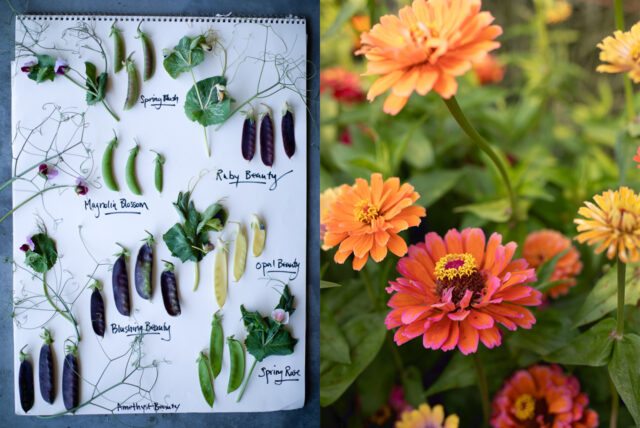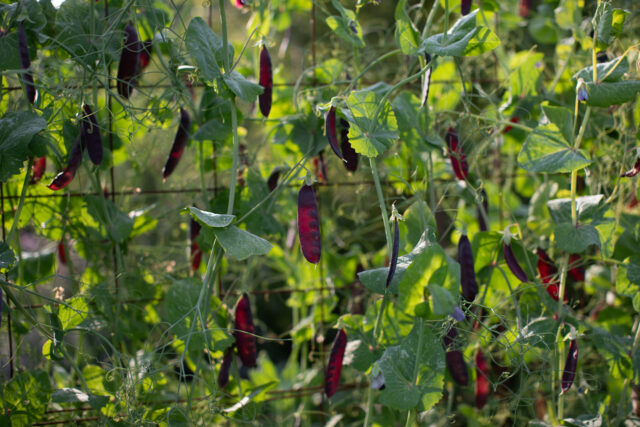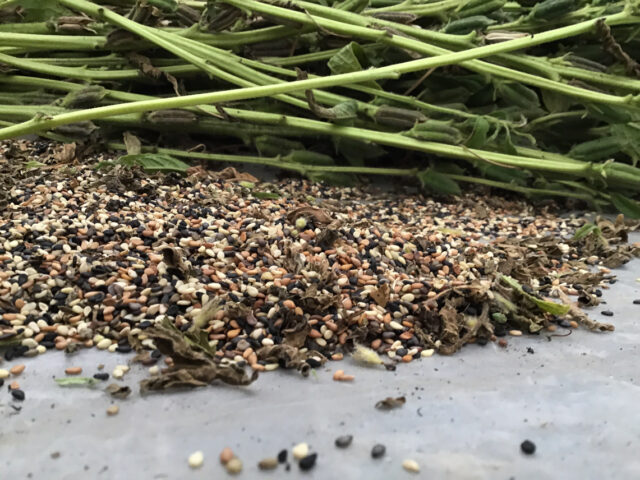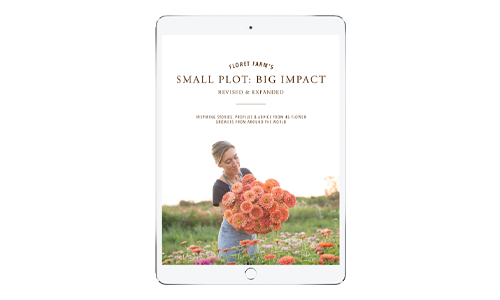I heard about Peace Seedlings, a delightful and obscure little seed company down in Oregon’s Willamette Valley, from Eric who heads up our seed program. He remembers Dylana Kapuler and Mario DiBenedetto selling their seeds in handwritten manila envelopes at the Corvallis Farmers Market when he lived there.
When I first visited their blog (which also functions as their main catalog) I was a little bit skeptical, since there was nowhere to place an order. But I quickly learned that they are still doing things the old-fashioned way and you have to mail them a list of what you want, plus a few dollars for shipping and payment (either cash or check). A few weeks later your order will appear in the mailbox.
 Last season I trialed all of their pea varieties that are part of their breeding program. I was incredibly impressed—they were all beautiful and delicious, and like nothing I’d ever grown before. If you’re looking for some fun and tasty additions to your garden, be sure to check them out!
Last season I trialed all of their pea varieties that are part of their breeding program. I was incredibly impressed—they were all beautiful and delicious, and like nothing I’d ever grown before. If you’re looking for some fun and tasty additions to your garden, be sure to check them out!
While their whole offering is very interesting, their zinnia collections are especially worth pointing out. They’ve been working to breed some very diverse mixes that are incredibly unique and very different from anything on the market.
While I’m typically drawn to softer pastel shades, the bright, wild, boldly colored bicolor flowers from their mixes were both eye-catching and bizarrely beautiful. If you’re looking for some one-of-a-kind flowers to add to your garden, fields, or bouquets I especially loved the Day Glow Mix and ‘Rainbow Eyes’.
Peace Seedlings specializes in breeding for diversity rather than uniformity, so if you’re on the hunt for some unusual and unique new treasures, look no further.
 Dylana, I’m so happy I found out about your operation, and I’m really excited to introduce you to Floret readers. Can you share a little bit about the evolution of your seed company? From what I’ve read, the original Peace Seeds was founded in the 1970s by your parents, but more recently, you’ve renamed it Peace Seedlings. Can you talk about this transition and what you’re focusing on now?
Dylana, I’m so happy I found out about your operation, and I’m really excited to introduce you to Floret readers. Can you share a little bit about the evolution of your seed company? From what I’ve read, the original Peace Seeds was founded in the 1970s by your parents, but more recently, you’ve renamed it Peace Seedlings. Can you talk about this transition and what you’re focusing on now?
We started helping with Peace Seeds, which was run by my parents “Mushroom” (Alan Kapuler) and Linda Kapuler, in 2007. My partner Mario DiBenedetto and I were inspired by the staggering legacy that they had created. Mushroom and Linda would talk about maybe “retiring,” but our involvement seemed to keep them inspired to keep truckin’ on.
By 2009, Mushroom encouraged us to start our own seed company so we could get credit for our own work. So that fall, we launched Peace Seedlings. We wanted to keep some continuity of the legacy they had created and we figured we were the next generation of Peace Seeds, and thus we were the “Seedlings.”
 We were too young to think through how much we would confuse people who thought we sold seedlings, or why two different seed companies worked together on the same 3-acre piece of land that Mushroom and Linda had been leasing since the early ‘90s.
We were too young to think through how much we would confuse people who thought we sold seedlings, or why two different seed companies worked together on the same 3-acre piece of land that Mushroom and Linda had been leasing since the early ‘90s.
The focus has always been on the preservation and dissemination of biodiversity, growing organic food that keeps ourselves and the community nourished, and breeding new varieties for the public domain that make a valuable contribution to increased nutrition, architectural advances, and unique beauty.
 You offer one of the most interesting and diverse ranges of seeds I’ve come across, and so many of the varieties in your catalog were bred on your farm. Can you share more about your breeding efforts and what you’re specializing in?
You offer one of the most interesting and diverse ranges of seeds I’ve come across, and so many of the varieties in your catalog were bred on your farm. Can you share more about your breeding efforts and what you’re specializing in?
Thank you, it means a lot to hear that. Like I said, the legacy of my parents is staggering, so we have tried our best to honor their work and all of the amazing varieties that we have had access to. We have tried to see and grow as many different types of plants as we can so we can have deeper insight and more appreciation of the natural world.
That leads to the next step, which is saving the seeds so you can be part of the whole cycle. Then once you grow those seeds, you might see a unique trait that you want to follow, and then you are doing your own level of adaptation and selection.
It is hard not to do this with everything we grow so after enough time, the hope is that we made a valuable contribution to as many varieties as possible.
 We’ve generally tried to be more diversified than specialized, but we have ended up being more attracted to certain plants for various reasons. We have done most of our breeding efforts in peas, corn, tomatoes, peppers, beans, marigolds, zinnias, sunflowers, and asters.
We’ve generally tried to be more diversified than specialized, but we have ended up being more attracted to certain plants for various reasons. We have done most of our breeding efforts in peas, corn, tomatoes, peppers, beans, marigolds, zinnias, sunflowers, and asters.
We have done some specializing in South American (Andean) crops. The Andean people are some of the oldest plant breeders and have made a lot of underutilized crops.
Many of them are very unknown for how much potential they have in gardens globally. One of which is Yacon (pictured above), which makes an edible tuber that is sweet and crunchy eaten raw or cooked, and is an amazing and adaptable plant in many climates.
 This past season we trialed all of your zinnia mixes and were amazed by the uniqueness and diversity found in each collection. I’ve never seen anything like them before! Would you be willing to share a little more about how these varieties came to be, especially the Day Glow Mix?
This past season we trialed all of your zinnia mixes and were amazed by the uniqueness and diversity found in each collection. I’ve never seen anything like them before! Would you be willing to share a little more about how these varieties came to be, especially the Day Glow Mix?
We have both been artists our whole lives with many different mediums. Zinnias were one of the earliest breeding projects we started. So as artists, we decided to grow a huge spiral of two different species of zinnias that normally didn’t cross and see if growing them like that would encourage more intercrossing from all the pollinators.
We grew out as many seeds as we could from the zinnia spiral and ended up noticing one plant that had a unique color trait that we knew was a cross.
That is the start of many of our zinnias that have the “multi-tone”(multiple colors) trait. For the next decade, we would grow as many plants as we could manage and every year pick our favorites and save each one separately to see what happened.
 Simultaneously we grew out as many zinnias as we could find in the commercial market that had unique colors or morphology and were tall enough for cut flowers.
Simultaneously we grew out as many zinnias as we could find in the commercial market that had unique colors or morphology and were tall enough for cut flowers.
Growing so many different types of zinnias and having a very diverse amount of pollinators created the possibility of anomalies to happen. A few years ago we noticed one plant that had a unique color trait that we named “multi-play.” We had never seen anything like it. The colors on the petals morphed over time so the old petals would be different from the newly emerging petals, which would create a glowing effect that we then named “Day Glow” (pictured above).
 In addition to trialing your zinnias, I also grew all of your snow and snap pea varieties, including ‘Ruby Beauty’, ‘Blushing Beauty’, ‘Amethyst Beauty’ (pictured above), ‘Opal Beauty’, ‘Spring Rose’, ‘Magnolia Blossom’, and ‘Spring Blush’. I was blown away by the range of unique colors and exaggerated tendrils on many of the varieties. They were all incredibly delicious, too. Can you share a little bit more about your pea breeding efforts and a few of your favorites or new varieties that you’d recommend trying?
In addition to trialing your zinnias, I also grew all of your snow and snap pea varieties, including ‘Ruby Beauty’, ‘Blushing Beauty’, ‘Amethyst Beauty’ (pictured above), ‘Opal Beauty’, ‘Spring Rose’, ‘Magnolia Blossom’, and ‘Spring Blush’. I was blown away by the range of unique colors and exaggerated tendrils on many of the varieties. They were all incredibly delicious, too. Can you share a little bit more about your pea breeding efforts and a few of your favorites or new varieties that you’d recommend trying?
It all started with the seed of inspiration to breed a rainbow of peas … My parents spent more than a decade trying to make the first edible purple pea pod. After some bitter failures and following many paths, some that led to other wonderful peas like ‘Green Beauty’, ‘Magnolia Blossom’, and ‘Spring Blush’, they succeeded and offered ‘Sugar Magnolia’, the first purple snap pea of its kind, which also had been selected for hyper-tendrils, a trait that was not readily available. A decade before that they bred ‘Opal Creek’, the first yellow snap pea.
So, at the beginning of working in collaboration with my parents, it was natural to be inspired by all they had done and see the potential for what was now possible with all these new varieties they had bred.
 The first pea we bred came from being enchanted by a pink-flowered New Zealand pea that a friend was growing and we knew we needed to use that as a parent. Using that pink-flowered pea crossed with ‘Green Beauty’ we made ‘Spring Rose’ (pictured above), which had the unique pink flower trait we were looking for. We hoped crossing yellow peas with purple peas would open up the possibilities of color and hopefully make a “red” pea.
The first pea we bred came from being enchanted by a pink-flowered New Zealand pea that a friend was growing and we knew we needed to use that as a parent. Using that pink-flowered pea crossed with ‘Green Beauty’ we made ‘Spring Rose’ (pictured above), which had the unique pink flower trait we were looking for. We hoped crossing yellow peas with purple peas would open up the possibilities of color and hopefully make a “red” pea.
But first, we crossed ‘Green Beauty’ to ‘Opal Creek’, so we could make a golden snow.
We then crossed the golden snow with ‘Sugar Magnolia’, hoping it would open up endless potentials since we crossed so many traits together. This work opened up Pandora’s box and it would take us about a decade to select almost a dozen new varieties of different colored snow and snap peas.

 New Peace Seedlings peas include ‘Opal Beauty’ (a golden snow vine pea; pictured above, top left), ‘Amethyst Beauty’ (a purple snow vine pea), and ‘Blushing Beauty’ (a purple splash over green snow pea); two beautiful magenta-colored varieties named ‘Ruby Beauty’ (a snow vine pea; pictured above, top right) and ‘Ruby Crescent’ (a snap vine pea); plus, ‘Opal Crescent’ (a yellow snap pea; pictured above, bottom left), ‘Purple Beauty’ (a dark purple snow pea; pictured above, bottom right), and ‘Sweet Rain’ (an XL green snap pea).
New Peace Seedlings peas include ‘Opal Beauty’ (a golden snow vine pea; pictured above, top left), ‘Amethyst Beauty’ (a purple snow vine pea), and ‘Blushing Beauty’ (a purple splash over green snow pea); two beautiful magenta-colored varieties named ‘Ruby Beauty’ (a snow vine pea; pictured above, top right) and ‘Ruby Crescent’ (a snap vine pea); plus, ‘Opal Crescent’ (a yellow snap pea; pictured above, bottom left), ‘Purple Beauty’ (a dark purple snow pea; pictured above, bottom right), and ‘Sweet Rain’ (an XL green snap pea).
We’d recommend trying any of the ones we offer now—they create an awesome addition to any garden or market booth.

 All of the varieties that you offer are open-pollinated and public domain. Can you explain a little more about what it means for a variety to be in the public domain, and why it’s important to you to offer these varieties?
All of the varieties that you offer are open-pollinated and public domain. Can you explain a little more about what it means for a variety to be in the public domain, and why it’s important to you to offer these varieties?
We are inspired by my genius father who was raised in the science world and saw too much progress get stymied by privatization and ownership, which led him to dedicate his life to working for the public domain. Public domain is like “open source” software, so it is free for the public to use.
When a variety is offered in the public domain through a published format it cannot be patented since there is a precedent of it existing, so it is protected from control by a corporation. When a public domain variety is passed from one generation to the next, it becomes a heirloom variety, so we like to think we are creating our generation of heirlooms.
This is important because access to food is a human right, seeds are the foundation of our food system, and the more it is controlled the more we slowly lose the freedom to save seeds.
 While you breed new varieties, you also focus on the preservation of heirloom varieties, which is wonderful to see. How did you become interested in preservation?
While you breed new varieties, you also focus on the preservation of heirloom varieties, which is wonderful to see. How did you become interested in preservation?
We have access to an amazing seed collection that my parents have been curating since the ‘70s. They had trialed many varieties over the decades, so when we started helping out there were many heirloom varieties we grew because they were just outstanding in terms of flavor and how they grew in our garden.
Varieties like ‘Palestinian Tomato’ (from Palestine, Ohio), ‘Aci Sivri Cayenne’ (from Turkey), and ‘Red Milan Onion’ (from Italy) have become staples in our food system at home. This is what gave us an initial appreciation for the preservation of many old varieties, but we have also gained a broader respect for the work our ancestors put in and want to honor them.
With so many varieties disappearing in the last 50 years, it seems like we owe it to past and future generations to preserve what we can.
 I have to say, I love that you’re still doing business in the old-school way with a simple listing of your offerings and requiring people to mail in a handwritten order along with their payment. It’s such a refreshing change from the fast-paced digital world that I’m used to. For readers who haven’t ordered from you before, can you walk us through the process of ordering your seeds?
I have to say, I love that you’re still doing business in the old-school way with a simple listing of your offerings and requiring people to mail in a handwritten order along with their payment. It’s such a refreshing change from the fast-paced digital world that I’m used to. For readers who haven’t ordered from you before, can you walk us through the process of ordering your seeds?
Thanks, we are old-school and mostly have kept our presence simple on the internet because we do not want to spend too much of our life in front of a screen. We would rather be in the garden and spending time with family and friends. We are also multi-faceted people and one of our other passions is willow weaving, making baskets, hats, and furniture. We hope to offer some of the many varieties of willow that we grow soon, too.
We have been making a simple written seed list since 2009. We send the new seed list out every year in January to the people who ordered the year before. We also have a “blog website”, which is basically the written seed list with a few pictures.
To order from either the internet or our written seed list, write or type your requests and send them with a check or money order for the cost of the seeds plus $7 USD for shipping to Peace Seedlings, 2385 SE Thompson St., Corvallis, OR 97333.
 What are you most looking forward to in the upcoming growing season, and what’s the best way for our readers to learn about your 2024 offerings?
What are you most looking forward to in the upcoming growing season, and what’s the best way for our readers to learn about your 2024 offerings?
We are always looking forward to a new growing season. We have many new zinnias to grow out, some new red peas with pink flowers, and new bush peas we are working on, as well as an Aji pepper breeding project we are excited about, and also many others. Most of all, we are excited to watch our daughter Calypsa grow up in the garden and evolve; she will turn two on March 6.
The best way to find our offerings is to either go to our blog or you can request our paper seed list by emailing [email protected].
Thank you, Dylana. I’m really looking forward to growing more of your zinnias this year. I appreciate you taking the time to share your story and more about your breeding work with Floret readers.
 To accompany this interview, we’re giving away five special seed bundles. Each bundle will contain Peace Seedlings special Day Glow Mix zinnias, ‘Spring Blush’ snap peas, and ‘Ruby Beauty’ snow peas.
To accompany this interview, we’re giving away five special seed bundles. Each bundle will contain Peace Seedlings special Day Glow Mix zinnias, ‘Spring Blush’ snap peas, and ‘Ruby Beauty’ snow peas.
For a chance to win, simply post a comment below telling us about someone who has been influential to you as a gardener. Winners will be announced on January 16. Please note: This giveaway is open to U.S. residents only.
A huge congratulations to our winners: Emma, Elan Irving, Amber Harrison, Mel and Jessica Toloczko
To learn more and connect with Peace Seedlings, be sure to visit their blog.
Please note: If your comment doesn’t show up right away, sit tight; we have a spam filter that requires us to approve comments before they are published.







Carol Kolo on
Would love to try their unique seed varieties!